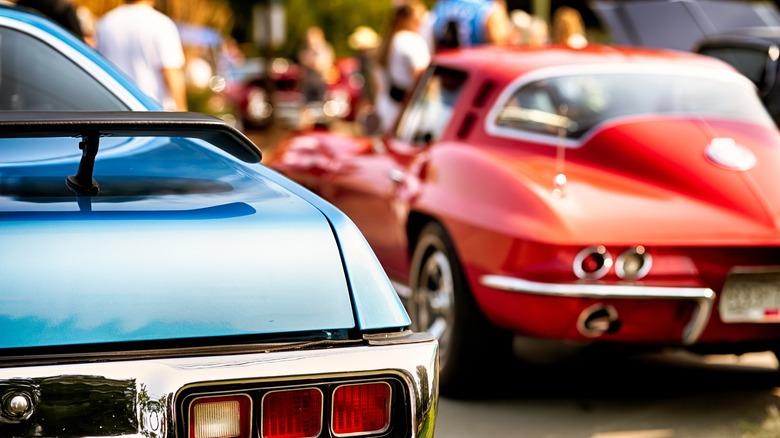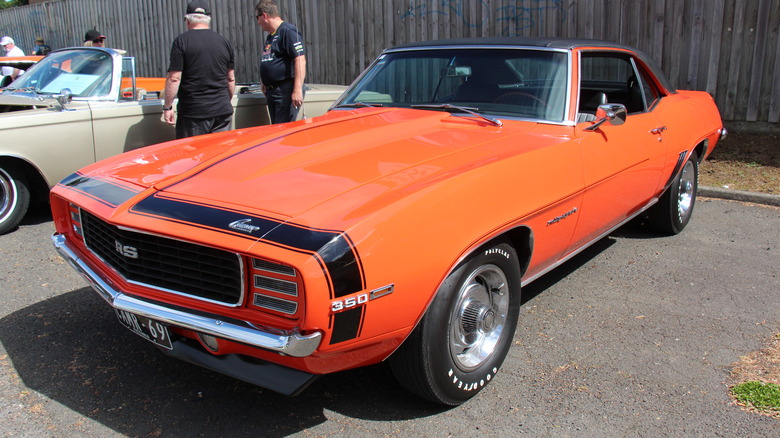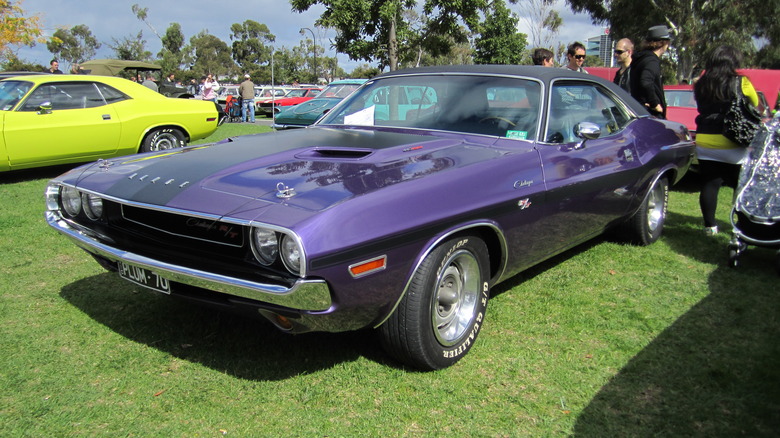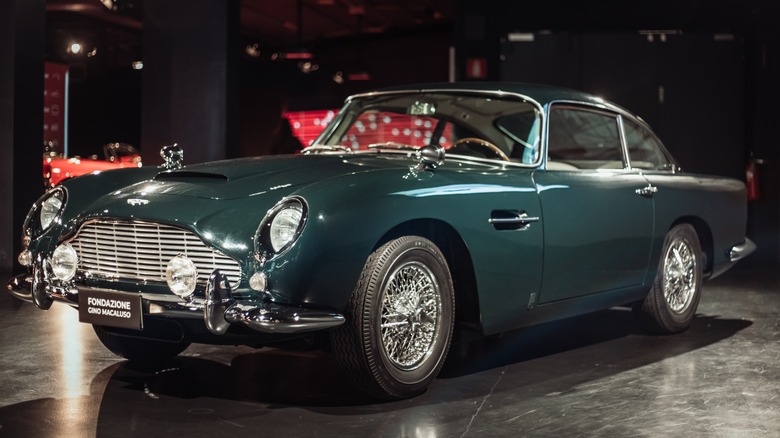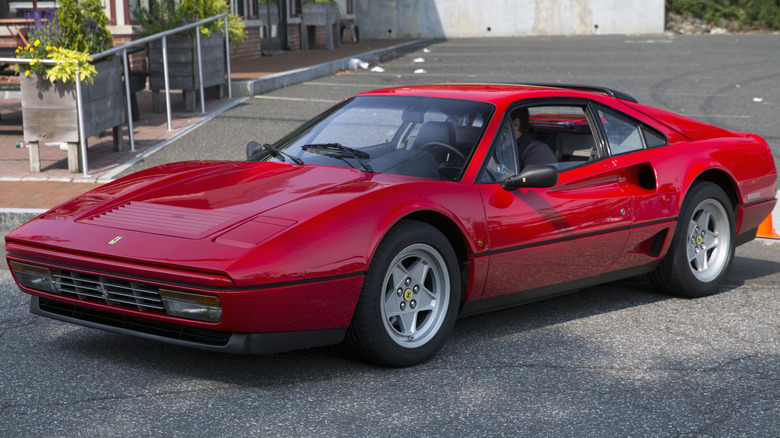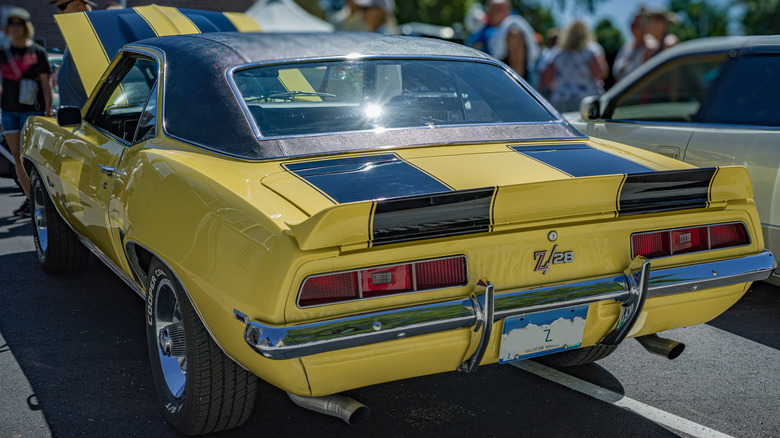5 Gorgeous Classic Car Colors That Deserve A Modern Comeback
Classic cars are loved for their power and beautiful design, but something that doesn't get as much attention is their iconic colors. Classic color schemes, like those found on the Ford Mustang, capture the spirit of the time and place when they were created. Looking at a beautiful classic color can transport you back to that era, and even if you didn't experience it firsthand, you can get a sense of what it was like. Certain colors are instantly recognizable and have become synonymous with power, speed, racing, and luxury.
Today, car colors seem to be relatively muted and most cars look somewhat similar. There are exceptions, but it's rare to see a color that stands out. And when you see a color that pops, it makes an impression and increases the chances of remembering the make and model of the car. Reintroducing these colors onto modern cars would give them more character, while also blending retro styling with the benefits of technology and safety. Let's take a look at five gorgeous and ultra stylish classic car colors that deserve a comeback.
Hugger Orange: the embodiment of the muscle car era
Hugger Orange is the embodiment of the 1960s muscle car movement. Hugger Orange is a brilliant, high-impact shade of orange that captures the rebellious American spirit. It blends a fiery appearance with a creamy, flat finish. The name is mainly associated with an American classic — the 1969 Camaro, which was dubbed "The Hugger" because it was super low to the road and had superior handling. Notably, some '69 Camaros in Hugger Orange are now worth upwards of seven figures. It was a popular color choice for American drivers seeking adventure and an assertive look to their cars.
The color has seen a few revivals in recent times. In 1999, Chevrolet brought the color back for the Camaro, giving muscle car enthusiasts a dose of nostalgia. Chevrolet only built 375 of the special edition Camaro SS, giving them instant rarity and collectability. Bringing back the Hugger Orange color today would create a sense of vibrancy and excitement for modern cars, and would likely be a hit for drivers seeking adventure wrapped in a retro flair.
[Featured image by Sicnag via Wikimedia Commons | Cropped and scaled | CC BY-SA 2.0]
Plum Crazy: purple for the bold at heart
Plum Crazy is a deep-hued purple that is also well known by muscle car enthusiasts. It exudes a daring and vibrant quality and sits between violet and dark lavender. Plum Crazy can give off warmer tones in direct sunlight and appears more intense and darker in lower lighting. The color was first introduced in 1969 as part of a campaign from Dodge and Plymouth called the high impact paint series. These bold colors were directly aimed at enticing young men who wanted to maximize the aggressiveness of their Mopar muscle cars.
Plum Crazy was well known for being sprayed onto the Dodge Challenger and Charger, with Plymouth offering their own version called In-Violet. Plum Crazy saw new life on the 2016 model year when Dodge brought back the iconic purple on Challengers and Chargers. The color option was available on multiple models and trims, including the iconic Hellcat. A comeback of Plum Crazy in modern times would give drivers a color option that's daring, unconventional, and has plenty of personality.
[Featured image by Sicnag via Wikimedia Commons | Cropped and scaled | CC BY-SA 2.0]
British Racing Green: a legacy of speed and heritage
British Racing Green is a dark shade of deep emerald green with black undertones that gives any vehicle wearing it a sophisticated look. In darker lighting, its hues can appear forest green or almost black. It's more than just a color: it symbolizes pride and an extensive British racing history. The color had somewhat of a quirky beginning. In the early 1900s, Britain had a national speed limit of a meager 12 mph. To race seriously, they had to travel into mainland Europe, where other nations had already been assigned the colors associated with Britain. After experiencing racing success, the British teams still couldn't host races because of the speed restrictions. That led to the 1903 Gordon Bennett Cup being held in Ireland. At the race, British drivers decided to paint their cars a deep emerald green as a nod to their gracious hosts.
As the years went on, the color found its way onto many iconic cars produced by Jaguar, Bentley, and Aston Martin. In the '50s and '60s, BRG was found on multiple Formula One cars, which further tied the color to Britain's racing roots. In more modern times, a handful of manufacturers have offered British Racing Green on its models, such as Jaguar, a special edition Mazda Miata, and even Tesla with its first generation Roadster. But it would be cool to see several more modern manufacturers offer cars in this nod to British racing history.
Rosso Corsa: fiery red Italian passion
Rosso Corsa, aka racing red or Ferrari red, has strong ties to Italian sports cars. A beautiful Ferrari in Rosso Corsa is likely the first thing that comes to mind. This bold, intense hue of red is extremely vibrant and deep. It exudes performance, appeal, heritage, and passion while highlighting the beautiful curves of Italian sports cars. The origins of Italians using red on their cars can be traced back to the 1920s, when officials assigned colors to help distinguish cars of different nations during races. Germany was assigned white, Belgium was assigned yellow, and Italy was assigned Rosso Corsa red.
As Ferrari experienced racing success in the late 1940s and onward, it was only natural to adopt the color associated with significant race wins throughout history. In addition to racing, Rosso Corsa has become one of the most popular choices for many Ferrari road car models. While Rosso Corsa is still offered on Ferraris today, it would be interesting to see modern American manufacturers offer the color. It would be a great nod to Italian racing heritage while giving American drivers a touch of European elegance.
[Featured image by Mr. Choppers via Wikimedia Commons | Cropped and scaled | CC BY-SA 3.0]
Daytona Yellow: bold and daring
Daytona Yellow is unusually bright and has a vibrant, high-energy feel. It's eye-catching due to its distinct, vivid saturation that isn't too warm or cold. The color has a certain richness that gives it depth and maturity while also having the ability to turn heads on the road. Daytona yellow is a symbol of speed and confidence for those seeking to maximize their driving experience.
One car that looks spectacular in Daytona Yellow is the 1969 Chevrolet Chevelle SS 396. In these rare Chevelles, a Daytona Yellow coat was equally rare, as a limited number were produced in this hue. This made the SS 396 a rare gem that was highly desired and still has a hefty price tag today. Any modern manufacturer would be smart to bring back Daytona Yellow today because it would create instant brand recognition with its high visual impact and exclusive feel.
From the bold and aggressive colors of 1960s muscle cars to the sophisticated greens used by Britain, classic colors are stunning to look at and remind us of our roots. They are more than reflected light — these colors embody the passion and triumphs of nations and individuals. Knowing this, modern car companies could benefit from bringing back these colors. It would be an easy way to usher in a new golden era of driving.
[Featured image by BUTTON74 via Wikimedia Commons | Cropped and scaled | CC BY-SA 4.0]
